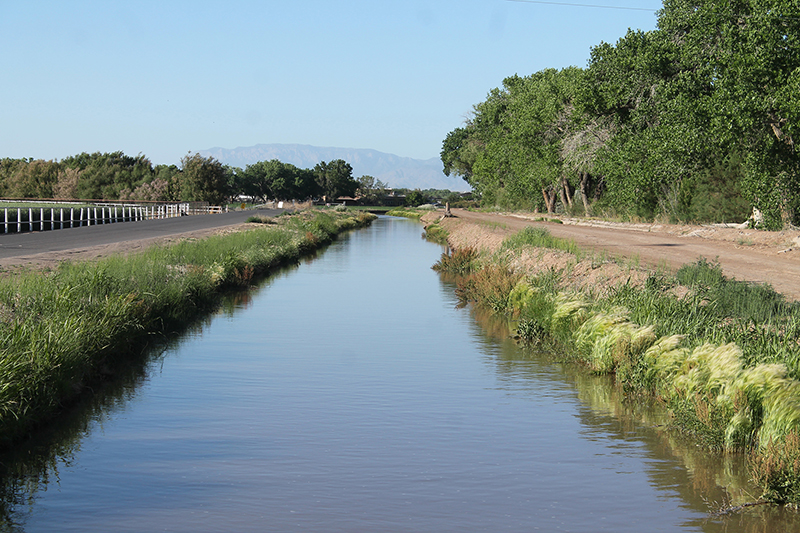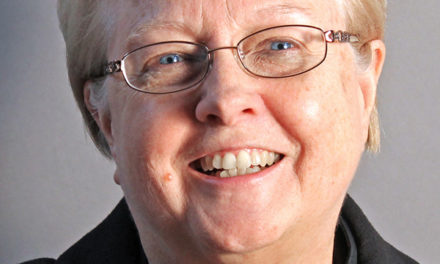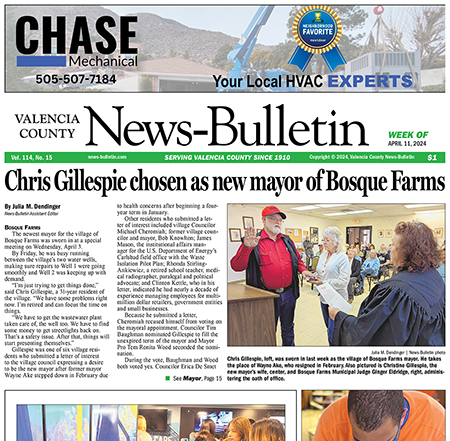LOS LUNAS — Only months into the 2022 irrigation season, Jason Casuga, chief engineer and CEO of the Middle Rio Grande Conservancy District, told the 50-plus farmers gathered at the Los Lunas Transportation Center last week the district was predicting irrigation waters would run out by the first week of June.
During a follow up interview on Friday, Casuga told the News-Bulletin the district might be able to keep ditches running until the third week of June.
“Based on the water meeting today (Friday, May 27), we’re hopeful that while a lot of the native water will be gone somewhere in the second week of June, if we can get there, we plan to use San Juan Chama water to extend that out another week, week and a half,” Casuga said. “If the best happens — outside of getting rain — we could get into the third week of June before we run out.”
Irrigation water for the MRGCD, which takes in the areas where its irrigation system runs through Sandoval, Bernalillo, Valencia and Socorro counties, comes from the Rio Grande Basin, which extends across the state line north into Colorado.
Most of the water comes from runoff from the snow pack at high elevations, and is referred to as native water. The San Juan Chama water comes to the state through a pipeline project that pulls water from a different basin in Colorado.
“What we deliver to mid valley farmers is that surface water … The way I like to explain it is there’s a cup of water with a straw in it. When you are drinking with your mouth, that’s surface water. Drinking from the straw is groundwater,” he said. “The two are linked so if there is over pumping (of groundwater) it does reduce the amount of surface water through infiltration.”

Julia M. Dendinger | News-Bulletin photo
The irrigation lateral that parallels Edeal Road in Tomé was running full last Wednesday afternoon, shortly after the Middle Rio Grande Conservancy District announced it would have enough water to let farmers irrigate through mid June, at best.
Casuga said irrigators and water users in the valley and throughout New Mexico have come to understand the connection between the two more and more.
“Most people in the middle valley, outside of our grandparents, grew up in the historically wettest period on record,” he said. “When there’s no problem, you don’t go looking for one. Now what we’re facing, due to the climate we have, is people are forced to research and understand where water comes from, and that’s a great thing.”
Only one thing can alleviate the coming drying of the ditches and river — rain. Casuga said if a big enough rain event occurs, the district will divert as much water as it can into its system but cautioned that users nearest the event would benefit most, with those further down the system seeing little if any water from a storm.
If farmers have a commercial well, they can irrigate using groundwater, Casuga said, noting that agriculture is a commercial activity.
“If you are producing a crop you need a commercial well. MRGCD does not control (wells) but if a farmer has that infrastructure, they can use it,” he said. “We rely on (the Office of the State Engineer) to police those wells.”
This irrigation season marks the second year of the district’s voluntary fallowing program, funded by $15 million in federal dollars allocated by the state. In 2021, about 760 agricultural acres were idled, with owners receiving $300 per acre. This year, there are about 2,600 acres in the program at $425 per acre.
The program has proved to be unpopular among farmers and MRGCD board members as well.
At Wednesday’s meeting, Kirsten Couevas, a regenerative farmer in Adelino, asked Casuga the semi-rhetorical question of ‘what happens when you fallow lands?’
“When you go dry, salt comes up and you’re changing the micro-climates,” Couevas continued. “You’re planning five years ahead. What is the plan to conserve water? This is not a drought; it’s the new climate and it is going to keep getting worse. Where’s the money to save water? If you keep fallowing, you’re going to be like my home state of Nevada — no water.”
Casuga said the fallowing program is not meant to be long term.
“The fallow program is (available) until 2025 and we are not forcing farmers to fallow,” he said.
MRGCD supervisor for Socorro County Glen Duggins said he didn’t like the fallowing program because it was taking agricultural water and giving it to “the feds, to the minnow. The river has been wetter since the MRGCD came in and before (the silvery minnow) it survived. If it doesn’t survive, is it really going to make a dam? … somewhere, humans has to come first. This is the high desert. We were born in a drought and we will get through it.
“I don’t believe you can idle a farm and just kick it back open. If I idle down, what am I telling my son? I’m done, I’m dead.”
During a phone interview after Wednesday’s meeting, Casuga said there was no desire on the part of the district or the state to end farming in the valley
“My job is to offer alternatives to folks,” he said. “My hope is, if a farmer is choosing this program, they are taking those funds and leveraging it on improvements to be ready to irrigate next year, to reinvest and make their farm more efficient.”
He added the money could also be used to leverage federal grant funding, which typically asks farmers for a cost share.
“We owe it to the public to be better at offering better paths forward. The district has what I think of as a triangle of responsibilities — irrigation, the ecosystem and the compact — and we try to make that triangle as equal as possible. If any one of those gets too far out of balance, our primary customer is going to suffer — the farmer.”
One of those legs of the triangle Casuga referred to is the Rio Grande Compact, a water sharing agreement among New Mexico, Colorado, Texas and Mexico. Under the terms of the compact, New Mexico is obligated to deliver a share of water to Texas annually.
By the end of 2021, the state was in “debt” to Texas for 127,000 acre-feet of water. As of May, New Mexico has under-delivered by an additional estimated 30,000 acre-feet of water.
“I want to be clear: Compact debt is not the MRGCD or farmers’ responsibility. New Mexico, as a whole, is but a large portion of the water does move through the middle valley and ag is a large drinker of that water,” Casuga said. “It often does feel like farmers take the brunt. When there are municipal and industrial uses, they come ask agriculture to give up water. Ag is the biggest source they can draw from. We typically work with them but at the end of the day, the ramifications fall to us and our farmers if the compact is not satisfied.”
The outlook for water as far out as 2026 isn’t good, the CEO said. Under certain circumstances, the district can store irrigation water behind El Vado Dam on the northern end of the irrigation system, but right now, terms of the compact don’t allow for storage.
Even if the district was allowed to store water upstream and release it later in the season, the dam, which is owned by the federal government, is currently being rehabilitated and there’s no way to store water at El Vado.
“Conditions are changing so drastically. We expect to see areas (on the Rio Grande) dry that haven’t since 1983,” he said. “I really wish I had better news.”
Janet Jarratt, whose family has farmed in the middle Rio Grande Valley for more than six decades, asked the district to let farmers fight for it and themselves.
“I think the district has a lot of options to pursue without the state engineer. We are growing real food for real people. This is not a game we’re playing,” Jarratt said at the Wednesday meeting. “Let us do something besides yell at you guys. You have a lot of data but I think you don’t have the historical perspective.
“Let us help you. Give us the data. It’s a political season and farmers rate very high on the trust scale. If they are going to play politics, let us help. Let us help ourselves.”
Julia M. Dendinger began working at the VCNB in 2006. She covers Valencia County government, Belen Consolidated Schools and the village of Bosque Farms. She is a member of the Society of Professional Journalists Rio Grande chapter’s board of directors.
















